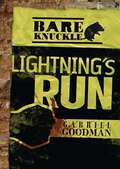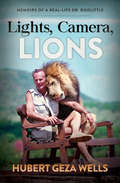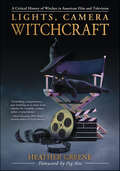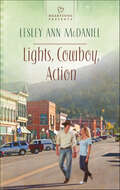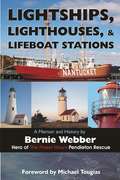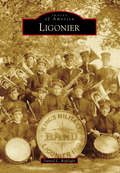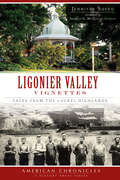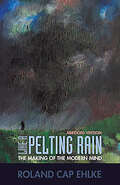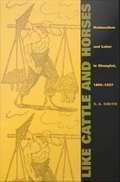- Table View
- List View
Lightning in the Sky: The Story of Jimmy Doolittle
by Carl MannOriginally published in 1943, this is a biography of Jimmy Doolittle (1896-1993), a highly decorated officer in the United States Army Air Corps who pioneered in all phases of aeronautical achievement and commanded the Doolittle Raid on Japan during World War II.He became the first pilot to take the "blind" out of flying and complete the "outside loop", set numerous speed records, and won many racing trophies. Promoted to lieutenant general, he was also awarded the Medal of Honor for his valor and leadership as commander of the Doolittle Raid, a bold long-range retaliatory air raid on the Japanese main islands weeks after the attack on Pearl Harbor. His Tokyo flight is widely regarded as one of the coups of the Second World War.Doolittle also commanded the 12th Air Force over North Africa, the 15th Air Force over the Mediterranean, and the 8th Air Force over Europe.
Lightning's Run (Bareknuckle Ser.)
by Gabriel GoodmanHiram's father forbids violence. It's against their family's beliefs. Even so, Hiram has been sneaking out to the Woodrat Club, where bareknuckle fighters compete and shady deals go down. Tired of beatings from a local bully, Hiram wants to learn how to box. He finds a willing teacher in Lightning, one of the Woodrat's finest fighters. Hiram, a Jewish immigrant, and Lightning, a former slave, soon form an unlikely friendship. But Lightning has troubles of his own. When a man from Lightning's past appears in New York, will Hiram's new boxing skills be enough to help his friend?
Lightning's Run (Bareknuckle)
by Gabriel GoodmanHiram's father forbids violence. It's against their family's beliefs. Even so, Hiram has been sneaking out to the Woodrat Club, where bareknuckle fighters compete and shady deals go down. Tired of beatings from a local bully, Hiram wants to learn how to box. He finds a willing teacher in Lightning, one of the Woodrat's finest fighters. Hiram, a Jewish immigrant, and Lightning, a former slave, soon form an unlikely friendship. But Lightning has troubles of his own. When a man from Lightning's past appears in New York, will Hiram's new boxing skills be enough to help his friend?
Lights Along the Way: Great Stories of American Faith
by Thomas J. FlemingOur history books are full of important episodes in America's past, and of general biographies of those who have made that history. Rarely do they record, however, how an individual's faith shaped those events. Here, filling in the missing pieces, are thirty-seven portraits of defining moments in American religious history ranging from the Pilgrims to contemporary figures, including: Samuel Sewall, Ben Franklin, George Washington, Johnny Appleseed, Sojourner Truth, Emily Dickinson, Robert E. Lee, Woodrow Wilson, Dorothy Day, Bess Truman, John F. Kennedy, and others.
Lights Out Liverpool: (Pearl Street 1)
by Maureen LeeNumber One bestseller Maureen Lee's first novel of the hugely popular Pearl Street series.As Britain stands alone against a monstrous enemy, the inhabitants of Pearl Street, in Liverpool, face hardship and heartbreak with courage and humour.The war touches each of them in a different way: for Annie Poulson, a widow, it means never-ending worry when her twin boys are called up and sent to France; Sheila Reilly's husband, Cal, faces the terror of U-Boat attacks; Eileen Costello is liberated from a bitter, loveless marriage when her husband is sent to Egypt and she goes to work in a munitions factory - and falls in love. And Jessica Fleming, down on her luck, is forced to return to the street she'd hoped never to see again.
Lights Out Liverpool: (Pearl Street 1)
by Maureen LeeNumber One bestseller Maureen Lee's first novel of the hugely popular Pearl Street series.As Britain stands alone against a monstrous enemy, the inhabitants of Pearl Street, in Liverpool, face hardship and heartbreak with courage and humour.The war touches each of them in a different way: for Annie Poulson, a widow, it means never-ending worry when her twin boys are called up and sent to France; Sheila Reilly's husband, Cal, faces the terror of U-Boat attacks; Eileen Costello is liberated from a bitter, loveless marriage when her husband is sent to Egypt and she goes to work in a munitions factory - and falls in love. And Jessica Fleming, down on her luck, is forced to return to the street she'd hoped never to see again.
Lights Out: Islam, Free Speech and the Twilight of the West
by Mark Steyn"Free speech is the whole thing, the whole ball game. Free speech is life itself." Salman Rushdie said. Mark Steyn and McLane's, the premier Weekly News Magazine, were attacked by the Islamists using the human rights commissions of Canada. Mr. Steyn shows us how to defend free speech and what will too soon happen if we don't. Roaming from America to Europe to Australia, Lights Out is a trenchant examination of the tensions between a resurgent Islam and a fainthearted west - and of the implications for liberty in the years ahead. In 2007, the Canadian Islamic Congress brought three suits against Maclean s, Canada s biggest-selling newsweekly, for running an excerpt from Steyn s bestselling book America Alone, plus other flagrantly Islamophobic columns by the author. A year later the CIC had lost all its cases and Steyn had become a poster boy for a worldwide phenomenon - the collision between Islam, on the one hand, and, on the other, western notions of free speech, liberty and pluralism. In this book, Steyn republishes all the essays the western world's new thought police attempted to criminalize, along with new material responding to his accusers. Covering other crises from the Danish cartoons to the Salman Rushdie fatwa, he also takes a stand against the erosion of free speech, and the advance of a creeping totalitarian "multiculturalism"; and he considers the broader relationship between Islam and the west in a time of unprecedented demographic transformation.
Lights Out: Pride, Delusion, and the Fall of General Electric
by Thomas Gryta Ted MannHow could General Electric—perhaps America&’s most iconic corporation—suffer such a swift and sudden fall from grace? This is the definitive history of General Electric&’s epic decline, as told by the two Wall Street Journal reporters who covered its fall. Since its founding in 1892, GE has been more than just a corporation. For generations, it was job security, a solidly safe investment, and an elite business education for top managers. GE electrified America, powering everything from lightbulbs to turbines, and became fully integrated into the American societal mindset as few companies ever had. And after two decades of leadership under legendary CEO Jack Welch, GE entered the twenty-first century as America&’s most valuable corporation. Yet, fewer than two decades later, the GE of old was gone. Lights Out examines how Welch&’s handpicked successor, Jeff Immelt, tried to fix flaws in Welch&’s profit machine, while stumbling headlong into mistakes of his own. In the end, GE&’s traditional win-at-all-costs driven culture seemed to lose its direction, which ultimately caused the company&’s decline on both a personal and organizational scale. Lights Out details how one of America&’s all-time great companies has been reduced to a cautionary tale for our times.
Lights on the Nile
by Donna Jo NapoliKepi is a young girl in ancient Egypt, content to stay home with her family, helping her father, who was wounded in the construction of a pyramid for the cruel pharaoh Khufu. But that was before she and her pet baboon, Babu, were kidnapped and held captive on a boat bound for the capital city, Ineb Hedj. And when Kepi and Babu are separated, she knows she has only one choice: to make her way to the capital on her own, rescue Babu, and find a way to appeal to the pharaoh. Khufu is rich and powerful, but Kepi has her own powers, deep inside her—ones she herself doesn’t even know about yet.Donna Jo Napoli, acclaimed author of Zel and Beast, revisits the fabled origin of fairies in this strikingly orig-inal and affecting novel of friendship.
Lights! Camera! Mayhem! (Chronicles of St. Mary's)
by Jodi TaylorJodi Taylor and the disaster magnets of St Mary's return with a story of chaos and catastrophe, to wish you a very Merry Christmas.Coming to a screen near you...TEMPORA, THE TIME TRAVELLING TOURISTStarring Astrid Gustafsson as Helen of Troy - 'the face that launched a thousand ships' With Dirk Thrust as Achilles - 'demi god and hero' And the Wooden Horse as Himself - 'easily the least wooden performance from anyone participating in this particular travesty' (Dr Maxwell)Watch and weep as this epic tale unfolds...*It's drama, darling! In this year's festive tale, the nation's favourite film producer, Calvin Cutter, returns to darken the doors of St Mary's once again... Readers love Jodi Taylor: 'The Chronicles of St Mary's is one of the most enjoyable series of books I have ever read' 'Jodi Taylor is a master storyteller''I don't think I've ever laughed out loud so much reading a book''I am always gutted when I finish a Jodi Taylor book as I know I will have to wait for the next one'
Lights! Camera! Mayhem! (Chronicles of St. Mary's)
by Jodi TaylorJodi Taylor and the disaster magnets of St Mary's return with a story of chaos and catastrophe, to wish you a very Merry Christmas.Coming to a screen near you...TEMPORA, THE TIME TRAVELLING TOURISTStarring Astrid Gustafsson as Helen of Troy - 'the face that launched a thousand ships' With Dirk Thrust as Achilles - 'demi god and hero' And the Wooden Horse as Himself - 'easily the least wooden performance from anyone participating in this particular travesty' (Dr Maxwell)Watch and weep as this epic tale unfolds...*It's drama, darling! In this year's festive tale, the nation's favourite film producer, Calvin Cutter, returns to darken the doors of St Mary's once again... Readers love Jodi Taylor: 'The Chronicles of St Mary's is one of the most enjoyable series of books I have ever read' 'Jodi Taylor is a master storyteller''I don't think I've ever laughed out loud so much reading a book''I am always gutted when I finish a Jodi Taylor book as I know I will have to wait for the next one'
Lights! Camera! Mayhem! (Chronicles of St. Mary's)
by Jodi TaylorJodi Taylor and the disaster magnets of St Mary's return with a story of chaos and catastrophe, to wish you a very Merry Christmas.Coming to a screen near you...TEMPORA, THE TIME TRAVELLING TOURISTStarring Astrid Gustafsson as Helen of Troy - 'the face that launched a thousand ships' With Dirk Thrust as Achilles - 'demi god and hero' And the Wooden Horse as Himself - 'easily the least wooden performance from anyone participating in this particular travesty' (Dr Maxwell)Watch and weep as this epic tale unfolds...*It's drama, darling! In this year's festive tale, the nation's favourite film producer, Calvin Cutter, returns to darken the doors of St Mary's once again... Readers love Jodi Taylor: 'The Chronicles of St Mary's is one of the most enjoyable series of books I have ever read' 'Jodi Taylor is a master storyteller''I don't think I've ever laughed out loud so much reading a book''I am always gutted when I finish a Jodi Taylor book as I know I will have to wait for the next one'
Lights, Camera, Lions: Memoirs of a Real-Life Dr. Doolittle
by Hubert Geza WellsA unique and entertaining memoir of training and working with animal actors. Lights, Camera, Lions tells the remarkable story of Hungarian Hubert Geza Wells, who defects to America during the communist era and goes on to make a name for himself as one of the most sought-after animal trainers in Hollywood. With tales from his long career, which included filming on five continents and working on over a hundred films including Out of Africa and Born Free, his hair-raising memoir (pun intended) also provides insight into training animals that has never been revealed before.
Lights, Camera, Witchcraft: A Critical History of Witches in American Film and Television
by Heather GreeneFollow the Witch Through Decades of American EntertainmentDeviant mistress of the dark arts. Goddess worshipper dancing in the moonlight. Crystal-wielding bookworm with a black hat and broom. We recognize the witch because no industry has been quite so influential in shaping our vision of her as Hollywood. This comprehensive book delves into the fascinating history of witchcraft and witches in American film and television.From Joan the Woman and The Wizard of Oz to Carrie and Charmed, author and film scholar Heather Greene explores how these movies and TV shows helped influence the public image of the witch and profoundly affected how women negotiate their power in a patriarchal society. Greene presents more than two hundred examples spanning silent reels to present-day blockbusters. As you travel through each decade, you'll discover compelling insights into the intersection of entertainment, critical theory, gender studies, and spirituality.
Lights, Cowboy, Action
by Lesley Ann McDanielMatchmaking is not in Courtney’s job descriptionAs assistant to a famous actress, Courtney is used to fulfilling ridiculous requests. Then her boss demands a date with handsome cowboy Adam Greene while on location in Montana. Delivering up Adam just doesn’t seem right. Especially since Courtney’s got her eye on him, too.Adam’s not interested in high-maintenance actresses. But he can’t deny his attraction to sweet, fresh-faced Courtney. How can a small-town guy compete with glitz and glamour? Leave it to a cowboy to wrangle himself a Hollywood ending....
Lightships, Lighthouses, and Lifeboat Stations: A Memoir and History
by Bernie Webber"Lightships, Lighthouses and Lifeboat Stations" is part history book, part memoir, written by Bernie Webber, recipient of the Coast Guard's highest award, the Gold Life-saving Medal, and hero of the Disney movie The Finest Hours. While the public will recognize Webber's name from the movie and the bestselling book by the same name, few people know that during his lengthy Coast Guard career he served on lightships (ships anchored in dangerous areas to warn other vessels of hazards) in addition to lifeboat stations (small boat rescue stations) and lighthouses. Webber poses the following question: "How did the lightship men cope with the isolation, constant loneliness, boredom, fear, or just sheer terror? All were part of life on board a lightship. Rough seas tossed the ship about, rearing up and down the anchor chain. This was a world of isolation, noise from operating machinery, and blasts from the powerful foghorn that went on for hours, sometimes days, at a time." Webber answers that question in this book, drawing on a combination of personal experience and meticulous historical research. Discussions of men going mad, lightships being run down by larger ships, anchor chains breaking, and lightships cast upon shoals are offset with humorous stories and the author's reflections on his best days at sea. Webber also explains some of the heroic actions of a few lightship men over the years, and points out that they received no recognition at the time. The isolation these men faced was intense, but they learned to make do with what they had. Fourteen historic photos are included, as well as a Foreword by Michael Tougias.
Lightships: Floating Lighthouses of the Mid-Atlantic
by Wayne KirklinLight boats, light vessels, lightships--before radar, depth-finders and satellite-guided navigation, mariners relied on floating lighthouses that lingered offshore as warning beacons in perilous waters.Moored near shifting shoals and treacherous reefs, lightships remained on station during all weather conditions and played a vital role in keeping America's waterways safe for navigation. From 1820 to 1985, light vessels warned of treacherous seas and pointed the way to safe harbors. In Lightships, author Wayne Kirklin chronicles the eighty-five ships that protected the mid-Atlanticcoast and the heyday of these special craft. From New York Harbor to the southernmost edge of North Carolina's notorious Cape Fear, Kirklin details the unsung role this fleet played in keeping America's merchant marines safe. Read Lightships to discovera forgotten but vital element of American maritime history
Ligonier (Images of America)
by Daniel L. ReplogleIsaac Cavin, of Ligonier, Pennsylvania, traveled to Indiana in 1830. He returned home and married Elizabeth Marker in 1834, and they traveled together to northern Indiana. In May 1835, he planned a new town and named it Ligonier. He built his home a few miles north of town and lived there for 52 years. The next big players were two German Jewish peddlers, Solomon Mier and Frederick William Straus, who traveled to the United States and settled in Indiana. After training with their uncle, they moved to Ligonier around 1854 because they were told the railroad would be coming to Ligonier and that it might be a good place to start up a business. The suggestion led to some wonderful times for Ligonier. Straus developed one of his businesses into the largest farm brokerage firm in the United States, and Mier developed one of his businesses into one of the largest farmland dealers in the Midwest. Images of America: Ligonier explores one of the most unusual small towns in the United States.
Ligonier Valley
by Sally ShireyNestled in the hills of western Pennsylvania, the Ligonier Valley has always had an air of mystery about it. The small towns and rolling countryside bear little witness to all that has occurred here. A fort was built but decayed and disappeared before being reconstructed recently. Many people have made significant contributions to the town and beyond, although time has lost many of their stories. The valley became an early industrial center with the growth of lumbering, mining, and iron production until the best resources were spent and these industries dwindled. Using hundreds of rare photographs, author Sally Shirey tells the story of this beautiful, historic area. In Ligonier Valley, readers can see the valley as it stood many years ago. After making the steep descent of Laurel Mountain, many pioneers were content to stay and build their lives in the valley. In 1758, the army of Gen. John Forbes erected Fort Ligonier. John Ramsey laid out the town of Ligonier around a public square called the Diamond. The influx of people, thanks to the Ligonier Valley Rail Road, gave rise to the hospitality industry in the valley. The Hotel Breniser, Ligonier Springs Hotel, and Kissell Springs Hotel were among those that served tourists and residents alike. Idlewild Park, dating from the 1870s, remains one of America's most beautiful amusement parks today. Reconstructed Fort Ligonier has been named to the National Register of Historic Places.
Ligonier Valley Vignettes: Tales from the Laurel Highlands (American Chronicles)
by Jennifer SopkoSecluded between Laurel Mountain and Chestnut Ridge, the Ligonier Valley has been the mountain playground of western Pennsylvania since the nineteenth century. Yet this picturesque retreat was at the tumultuous center of history--during the French and Indian War, Fort Ligonier was key to the British strategy, and in the late nineteenth century, the Ligonier Valley Rail Road helped transform the industry of the region. Author Jennifer Sopko traces the story of the valley and its residents through a series of fascinating vignettes. From the earliest histories to nostalgic reminiscences of the Ligonier Opera House, socials at the Valley Dairy ice cream parlor and bygone days at Idlewild Park, Sopko captures the history and spirit of the Ligonier Valley and its communities.
Lijssenthoek Military Cemetery (In Memory and in Mourning)
by Paul ChapmanThis is a comprehensive and highly emotive volume, borne of years of intensive research and many trips to the battlefields of the Great War. It seeks to humanise the Lijssenthoek Military Cemetery, to offer the reader a chance to engage with the personal stories of the soldiers whose names have been chiseled there in stone. Poignant stories of camaraderie, tragic twists of fate and noble sacrifice have been collated in an attempt to bring home the reality of war and the true extent of its tragic cost. It is hoped that visitors to the battlefields, whether their relatives are listed within or not, will find their experience enriched by having access to this treasure trove of stories.
Like A Pelting Rain: The Making of the Modern Mind
by Roland Cap EhlkeWhen it comes to analyzing today's culture, people talk about politics, economics, and even morals. Like a Pelting Rain: The Making of the Modern Mind goes deeper and looks at the spiritual condition of Western civilization.How we arrived at where we are is the long and complex interplay of theology and culture. Understanding the trends of the times does not necessitate accepting them. God calls upon Christians to contend for the faith. The Holy Spirit is still at work, and the Gospel remains the power of God for the salvation of all who believe!
Like A Thunderbolt: The Lafayette Escadrille And The Advent Of American Pursuit In World War I [Illustrated Edition]
by Roger G. MillerIncludes 29 IllustrationsThe advent of an American squadron, or "escadrille," within the French air force, the Service Aeronautique, had been far from a simple process. French leaders initially held the belief, common at the time, that the war begun in 1914 would be a short one. The potential value of American volunteers fighting for France both for propaganda purposes and for helping bring the power of the New World into the war on the side of the Allies was thus irrelevant at first. By early 1915, however, the French began to accept American volunteers and assign them to escadrilles. In early 1916, the Service Aeronautique united several of these men in an elite chasse unit, which quickly earned an enviable reputation for audacity, bravery, and élan.Success of this unit, the Lafayette Escadrille, had three consequences. First, its existence encouraged a large number of Americans, far more than needed in one escadrille, to volunteer for French aviation. These individuals, identified unofficially as members of a "Lafayette Flying Corps," served in numerous French air units. Second, the publicity surrounding the Lafayette Escadrille contributed favorable press for the Allied cause, strengthened ties between France and the U.S., and ultimately helped prepare the U.S. to participate on the Allied side of the conflict. Third, the existence of a large body of experienced American pilots provided combat veterans for the Air Service of the American Expeditionary Forces (AEF) in France when the U.S. ultimately entered the war. These veterans helped instill in the U.S. Air Service the attitudes and practices of the Service Aeronautique, an infusion especially reflected in two U.S. pursuit squadrons, the 103rd Aero Squadron, made up of Lafayette Escadrille pilots, and the 94th Aero Squadron, the most famous American combat squadron of the war.
Like Andy Warhol
by Jonathan FlatleyScholarly considerations of Andy Warhol abound, including very fine catalogues raisonné, notable biographies, and essays in various exhibition catalogues and anthologies. But nowhere is there an in-depth scholarly examination of Warhol’s oeuvre as a whole—until now. Jonathan Flatley’s Like Andy Warhol is a revelatory look at the artist’s likeness-producing practices, not only reflected in his famous Campbell’s soup cans and Marilyn Monroe silkscreens but across Warhol’s whole range of interests including movies, drag queens, boredom, and his sprawling collections. Flatley shows us that Warhol’s art is an illustration of the artist’s own talent for “liking.” He argues that there is in Warhol’s productions a utopian impulse, an attempt to imagine new, queer forms of emotional attachment and affiliation, and to transform the world into a place where these forms find a new home. Like Andy Warhol is not just the best full-length critical study of Warhol in print, it is also an instant classic of queer theory.
Like Cattle and Horses: Nationalism and Labor in Shanghai, 1895-1927
by S. A. SmithIn Like Cattle and Horses Steve Smith connects the rise of Chinese nationalism to the growth of a Chinese working class. Moving from the late nineteenth century, when foreign companies first set up factories on Chinese soil, to 1927, when the labor movement created by the Chinese Communist Party was crushed by Chiang Kai-shek, Smith uses a host of documents--journalistic accounts of strikes, memoirs by former activists, police records--to argue that a nationalist movement fueled by the effects of foreign imperialism had a far greater hold on working-class identity than did class consciousness. While the massive wave of labor protest in the 1920s was principally an expression of militant nationalism rather than of class consciousness, Smith argues, elements of a precarious class identity were in turn forged by the very discourse of nationalism. By linking work-related demands to the defense of the nation, anti-imperialist nationalism legitimized participation in strikes and sensitized workers to the fact that they were worthy of better treatment as Chinese citizens. Smith shows how the workers' refusal to be treated "like cattle and horses" (a phrase frequently used by workers to describe their condition) came from a new but powerfully felt sense of dignity. In short, nationalism enabled workers to interpret the anger they felt at their unjust treatment in the workplace in political terms and to create a link between their position as workers and their position as members of an oppressed nation. By focusing on the role of the working class, Like Cattle and Horses is one of very few studies that examines nationalism "from below," acknowledging the powerful agency of nonelite forces in promoting national identity. Like Cattle and Horses will interest historians of labor, modern China, and nationalism, as well as those engaged in the study of revolutions and revolt.

